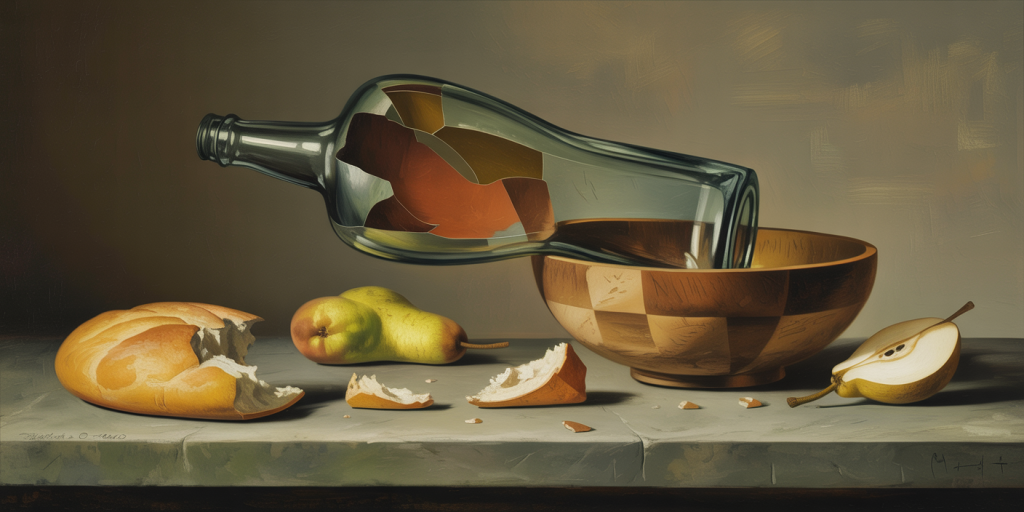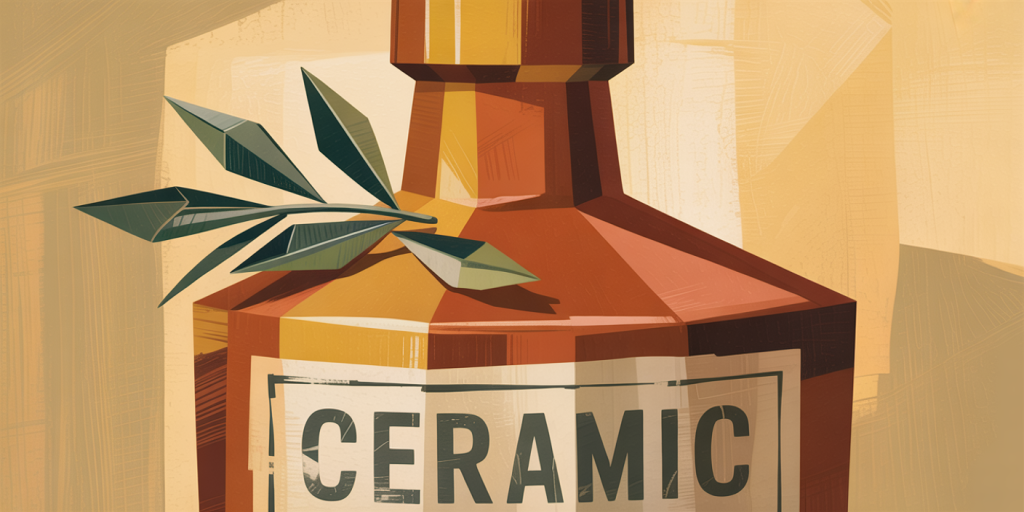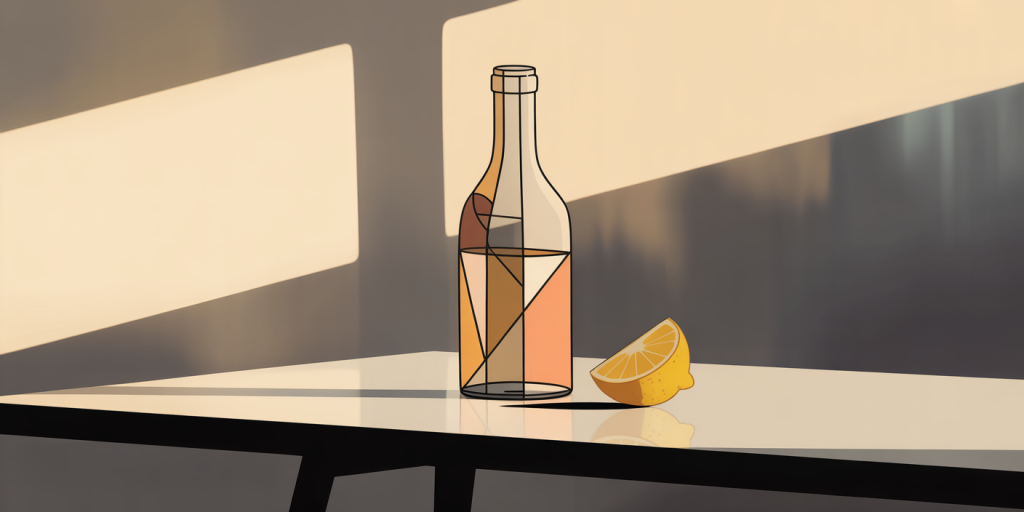Picasso’s Bottles and the Abstraction of the Motionless Everyday
Pablo Picasso
When the Everyday Stops Breathing and Begins to Dream
What happens when a bottle forgets it is a bottle? When a glass no longer holds wine, but the suggestion of a shape once held by a hand now vanished? In the still lives of Pablo Picasso—especially those born of the Cubist impulse—matter becomes memory, and the mundane is unraveled until it speaks in fragments. Here, a bottle is no longer an object. It is an idea. A ghost of gesture. A silent witness decomposed and reborn.
Within this strange quiet, the table trembles. The objects no longer rest—they pulse. The very stillness hums with fractured harmonies. Picasso’s bottles—those abstracted to their essence, layered with planes and possibilities—become invitations to perceive the unseen rhythm of the everyday, to listen to silence with geometrical ears, and to feel with angles rather than fingers.
Table of Contents
- The Bottle That Forgot Its Name
- Shadows that Fold like Paper
- Geometry of a Glass Never Held
- The Table as Collapsed Universe
- Brown, Beige, and the Color of Time
- Deconstruction as Devotion
- A Cork Suspended in Thought
- The Echoes Hidden in Woodgrain
- Silence in a Bottle’s Spine
- Transparency without Light
- ,When Wine is Only a Memory
- A Still Life Without Pulse, Yet Alive
- The Smell of Dust and Varnish
- Fragments as a New Kind of Wholeness
- Picasso’s Thirst for the Incomplete
- Line as Whisper, Form as Pause
- The Language of Tilt and Fragment
- Eyes That Build the Bottle Again
- The Poetics of Tabletop Gravity
- Stillness as Revolution
The Bottle That Forgot Its Name
In the Cubist world, objects dissolve their labels. A bottle is not a bottle—it is suggestion, shadow, memory. It becomes a puzzle where perception must be reassembled by the viewer. Picasso unnames the object to awaken its essence.
The result is deeply philosophical: we are not shown what the bottle looks like, but how it exists across time and angles. Its “bottleness” is not a surface—it is a condition. We do not see it; we are invited to reconstruct it.

Shadows that Fold like Paper
In traditional painting, shadows offer weight. In Picasso’s Cubism, they fold like notes passed in a classroom. They are not cast by light, but by thought. They deepen not volume, but mood.
These shadows become creases in space—creases of reflection, of hesitation. They fold the object inward, making the bottle a private room into which the viewer is gently invited.
Geometry of a Glass Never Held
Where is the glass? Its rim is a curve interrupted, its stem a slant. Picasso breaks it, not to destroy it, but to release it from function. The glass is no longer to be used—it is to be felt.
We do not drink from it. We inhabit it. Its transparency is now emotional. The glass becomes the fragility of perception itself, seen from multiple angles at once.
The Table as Collapsed Universe
The surface upon which the objects rest no longer obeys gravity. The table becomes a universe where perspective is uninvited. Its angles contradict, its edges bend into other edges.
This is not disorientation—it is intimacy. We are inside the moment, within the object’s internal architecture. The table, instead of bearing objects, bears the burden of abstraction.
Brown, Beige, and the Color of Time
Picasso’s bottles often live in muted tones—browns, greys, ochres. These are not dull choices. These are the colors of dusk, of aging pages, of thought. They slow the eye, hush the palette.
The colors are earthbound. They do not seduce; they endure. This color scheme is less a choice than a prayer: for silence, for inwardness, for objects that do not need to shine to be eternal.
Deconstruction as Devotion
Cubism is often misunderstood as chaotic. But in Picasso’s still lifes, deconstruction is not destruction—it is reverence. The bottle is not shattered in contempt, but carefully taken apart like a violin by a luthier.
Each fragment is examined, felt, placed with intention. The bottle is not lessened—it is expanded. Its presence is no longer singular—it becomes polyphonic.
A Cork Suspended in Thought
Even the cork is abstracted, no longer a plug but a poetic punctuation mark. It hovers above or beside, unscrewed from its duty. It becomes a dot above a bottle-shaped i.
The cork is tiny, but holds philosophical weight. It marks the pause between use and memory. It is the silent guardian of forgotten sips.
The Echoes Hidden in Woodgrain
The painted table sometimes shows the illusion of woodgrain—a wave of lines like fingerprint on furniture. But in Picasso’s hand, this woodgrain is more than texture; it is echo.
It suggests the passage of time across the surface. A table remembers every elbow, every stain. In Cubism, even woodgrain tells stories—ripples of the past flowing beneath abstraction.
Silence in a Bottle’s Spine
There is a verticality in some of Picasso’s bottles—a line that runs like a spine through the composition. It separates and connects, stabilizes and disrupts.
This spine is symbolic: it holds the silence of the composition together. It is the structure that lets the chaos hum rather than scream. The bottle’s silence is held, not spilled.
Transparency without Light
In Cubism, we see through things not because they are transparent, but because they are layered. The bottle shows us its interior, not by glass, but by rearrangement.
This is a new kind of seeing—not with the eye, but with the mind. Transparency here is a metaphor. It means openness to complexity, willingness to perceive multiple truths at once.
When Wine is Only a Memory
No liquid is ever painted. There is no red glint, no golden hue. The wine is implied, remembered, mourned. The bottle is not in use—it is after.
This delay of consumption transforms the scene. It is not a celebration, but a meditation. The absence of wine makes the bottle a reliquary of past joy, past communion.
A Still Life Without Pulse, Yet Alive
Cubism freezes motion by breaking it. Yet, strangely, the still life breathes. The absence of organic curves, the geometry, the dryness—all these are paradoxically full of life.
Why? Because abstraction is honest. It does not pretend. It presents the stillness of time, the true halt between moments, the heartbeat of objects when no one watches.

The Smell of Dust and Varnish
Though Cubism is visual, Picasso’s works evoke scent. The dryness of color, the paper-like textures, the matte finishes—they smell of dust, of old books, of still rooms.
This olfactory aura adds emotion. We feel the studio, the moment of pause, the varnish sealing history into quiet surfaces. We do not just see the still life—we breathe it.
Fragments as a New Kind of Wholeness
The parts no longer build the whole—they question it. And yet, in that questioning, the whole becomes more profound. We are not given unity—we are given participation.
Each viewer reassembles the bottle differently. The art lives not in the image, but in the act of viewing. Fragmentation becomes generosity.
Picasso’s Thirst for the Incomplete
Picasso did not seek perfection. He sought possibility. His thirst was not for finality, but for open forms. The bottle is never finished—it is always becoming.
This approach liberates both object and observer. The bottle is an invitation, not a conclusion. A question rather than an answer. A thirst that teaches us how to look again.
Line as Whisper, Form as Pause
Lines in Picasso’s bottle works are often thin, suggestive. They whisper the shape rather than declare it. They pause, shift direction, disappear.
These are not architectural lines—they are poetic. They do not bind—they beckon. Each form is less a thing than a moment of attention, briefly held before it dissolves again.
The Language of Tilt and Fragment
Tilt in Cubism is emotional. A bottle leaning is a mind turning. A fragment displaced is a feeling reexamined. Picasso’s language is not spoken—it is tilted, broken, gestured.
These gestures are not violent—they are lyrical. The table tilts like a sigh. The glass curves like a forgotten thought. Fragmentation becomes rhythm.
Eyes That Build the Bottle Again
The viewer is co-creator. Our eyes must do the work the brush only began. We must build the bottle again—slowly, tenderly, forgiving its incompleteness.
And in doing so, we discover our own fragmented perceptions. Picasso’s bottle becomes a mirror—not of form, but of seeing itself. We do not just view—it views us.
The Poetics of Tabletop Gravity
Objects on the Cubist table do not obey natural weight. A fork might float, a bottle might sink. This defiance is intentional—it frees the scene from domesticity.
Gravity becomes a metaphor for attachment. When denied, the objects become spiritual, inner, unmoored. The everyday is lifted—not into heaven, but into symbol.
Stillness as Revolution
In breaking the still life, Picasso did not end it. He expanded it. His bottles are revolutionary precisely because they are silent. They show that the radical need not be loud.
Stillness becomes a form of rebellion. Against realism. Against simplicity. Against a world that demands objects stay put and mean only one thing. In Picasso’s hands, they escape.

FAQ – Understanding Picasso’s Bottles
What is the significance of bottles in Picasso’s still lifes?
Bottles represent the ordinary world. By abstracting them, Picasso transforms the mundane into philosophical reflection. They become vessels of perception, not just wine.
What is Cubism, and how does it relate to this theme?
Cubism, co-founded by Picasso, is an art movement that deconstructs forms into geometric components to show multiple perspectives simultaneously. Bottles were a key motif in this exploration.
Why are the colors so muted in these works?
Muted palettes highlight form and structure over emotion. The earthy tones create a contemplative atmosphere, aligning with the analytical nature of early Cubism.
How does abstraction affect our emotional response?
Abstraction removes narrative and invites introspection. It allows the viewer to find meaning beyond surface, often evoking deeper emotional or intellectual engagement.
Where can I see Picasso’s bottle still lifes?
Many are housed in major collections like the Musée Picasso in Paris, MoMA in New York, and various European museums. They span across his Analytical and Synthetic Cubist periods.
Final Reflections – When Stillness Begins to Speak
A bottle on a table is nothing extraordinary. Until Picasso asks it to speak. Until he removes its skin and shows us the soul of a form we thought we knew. He does not beautify it—he dignifies it. He listens to the silence it holds.
In these works, the everyday is no longer passive. It hums. It trembles with geometry. The cork, the glass, the bread become ideas in orbit, held not by gravity but by vision.
And so we, too, learn to look again—not for what a thing is, but for what it might become when freed from function. In Picasso’s bottles, we find the abstraction of not just still life, but of life stilled long enough to become poetry.
